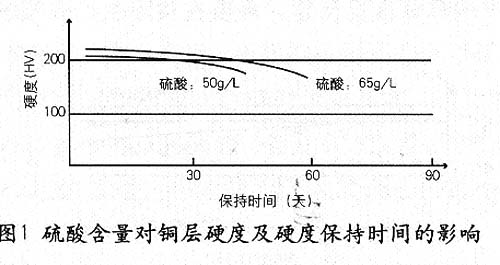1. Copper sulphate
The content of copper sulfate has little effect on the hardness of the copper plating layer and can even be ignored. However, as the main salt of the plating process, the content must be controlled. The low content of copper does not satisfy the need for high current density, resulting in defects such as rough coatings, blisters, and burrs, and the possibility of scorching in high current density regions is high. The increase of copper content is limited by its solubility, and its solubility decreases with the increase of sulfuric acid content. Once the plating bath encounters the plate cylinder with lower temperature, copper sulfate will crystallize on the surface, affecting the binding force of the plating layer, In addition, the quality of the electroplating layer is reduced. If small crystals are trapped in the crystal lattice of the copper layer, inclusion stress will occur, which will easily cause abrasion of the electric engraving needle. Larger copper sulfate crystals will also cause defects such as blisters, burrs and pinholes. And even rework.
2. sulfuric acid
Sulfuric acid is a strong electrolyte that can significantly increase the conductivity of the bath and also prevent the precipitation of copper sulfate by hydrolysis. Sulfuric acid content is low, the dispersion capacity and depth of the bath are poor, resulting in reduced brightness and flatness of the coating (especially the low current density zone), but also the anode passivation, tank voltage increase, waste of energy; sulfuric acid content If it is too high, the solubility of copper sulfate will be reduced, and the copper sulfate will rise too quickly during the production process, which will also cause quality problems. In addition, the content of sulfuric acid has certain influence on the hardness and holding time of the copper layer. As shown in Fig. 1, increasing the concentration of sulfuric acid can increase the electrochemical polarization of the cathode and make the formation speed of the crystal nucleus larger than that of the nucleus. The crystals are fine and tight, and the interatomic force in the crystal lattice is also large, so the hardness of the plating layer can be improved.

3. Chloride
Chloride ion is an indispensable inorganic anion in acid copper plating technology. Without chloride ion, the ideal bright copper layer cannot be obtained. The content of chloride ion is too low. The coating is rough, the internal stress of the copper layer is too large, and the high current density zone is ribbed. The distribution of burrs, in severe cases, the copper layer will burst; If the content is too high, it will easily generate pits, and affect the brightness and leveling, and excessive consumption of additives in the production process; when the content is seriously exceeded, It is easy to form a white chloride film on the anode surface, which affects the normal dissolution of the anode. In addition, the chloride ion content has little effect on the hardness and hardness holding time of the copper layer.
4. Open cylinder agent
The opener is mainly a carrier for some brighteners and hardeners. The main component is a surfactant. When used to open the cylinder, it can broaden the upper limit of cathode current density to a large extent. If the content is too low, the effect of the leveling agent may be affected, the high current density region is easily scorched, and the internal stress of the copper layer is too large, which is unfavorable for electronic engraving. Since these surfactants have a particularly strong adsorption capacity on the surface of the electrode, excessive addition thereof also affects the effects of the hardener and the brightener, so that the brightness and hardness of the coating and the hardness holding time decrease, as shown in FIG. 2 . In addition, if the content is too high, a hydrophobic film that is invisible to the naked eye is easily formed on the surface of the cathode, so that the binding force of the plating layer is reduced.

5. hardener
Hardeners have both hardening and brightening effects. During the electroplating process, the cathodic polarization can be effectively improved, the crystal nuclei can be generated at a much faster rate than the growth of crystal nuclei, so that the crystals are fine and the copper layer is bright. At the same time, the microscopic dispersion ability of the plated layer can be effectively improved, and the unevenness of the electrode surface can be obtained. Leveling can also effectively increase the brightness of the coating. There are two aspects of this kind of hardening agent to increase the hardness of the coating. On the one hand, due to the increase of the cathode polarization, the interaction force in the crystallization process after ion reduction can be increased, and the hardness of the copper layer can be improved. On the other hand, certain components of such hardeners can be trapped in the crystal lattice of the copper layer, and the inner stress of the copper layer is evenly increased, so that the hardness of the plating layer is improved. The effect of hardener on hardness and hardness retention time of the coating is shown in FIG. 3 . Hardener in the plating solution content is too small, the hardness of the just-plated copper layer is not too much, but the hardness retention time will be significantly shortened, the brightness is not ideal, especially in the low current density area. If the content of hardener is too high, the effect of the leveling agent will be inhibited, the probability of surface defects will increase, the focal spot will be generated in the high current density area, the internal stress of the copper layer will also increase, and the hardness will increase, which is unfavorable for electronic engraving.
